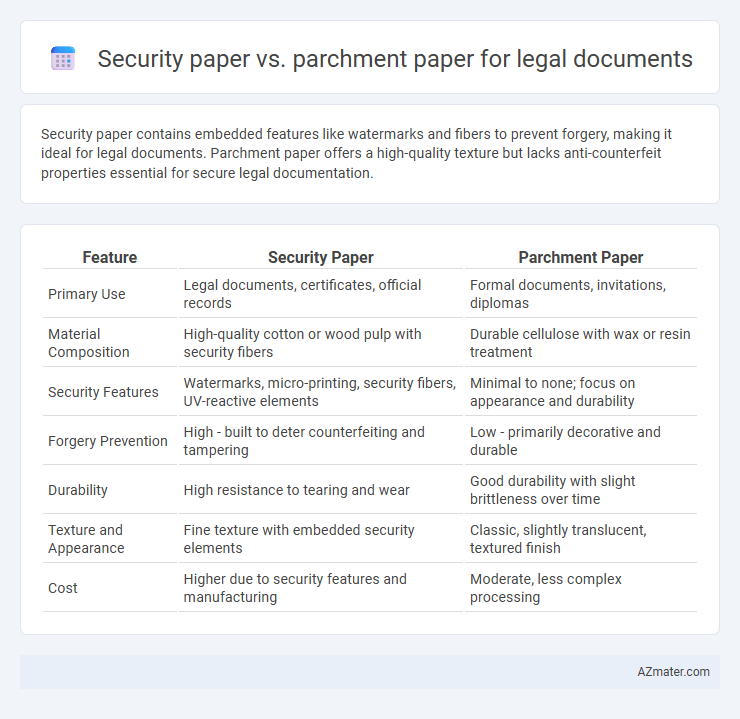Security paper contains embedded features like watermarks and fibers to prevent forgery, making it ideal for legal documents. Parchment paper offers a high-quality texture but lacks anti-counterfeit properties essential for secure legal documentation.
Table of Comparison
| Feature | Security Paper | Parchment Paper |
|---|---|---|
| Primary Use | Legal documents, certificates, official records | Formal documents, invitations, diplomas |
| Material Composition | High-quality cotton or wood pulp with security fibers | Durable cellulose with wax or resin treatment |
| Security Features | Watermarks, micro-printing, security fibers, UV-reactive elements | Minimal to none; focus on appearance and durability |
| Forgery Prevention | High - built to deter counterfeiting and tampering | Low - primarily decorative and durable |
| Durability | High resistance to tearing and wear | Good durability with slight brittleness over time |
| Texture and Appearance | Fine texture with embedded security elements | Classic, slightly translucent, textured finish |
| Cost | Higher due to security features and manufacturing | Moderate, less complex processing |
Introduction to Legal Document Paper Types
Legal document paper types include security paper and parchment paper, each designed to enhance document authenticity and prevent forgery. Security paper incorporates features like watermarks, microprint, and special fibers to deter counterfeiting and tampering, making it ideal for sensitive legal contracts and certificates. Parchment paper offers a durable, high-quality surface with a distinct texture that conveys formality and permanence, often used for official deeds and archival legal documents.
Defining Security Paper
Security paper is specially designed to protect legal documents from forgery, tampering, and unauthorized duplication through embedded features such as watermarks, microprinting, security fibers, and chemical sensitivity. Unlike parchment paper, which is primarily valued for its texture and durability, security paper integrates advanced anti-counterfeit technologies to ensure the authenticity and integrity of sensitive legal records. The use of security paper is critical in legal contexts where document verification and protection against fraud are paramount.
Understanding Parchment Paper
Parchment paper offers a durable, high-quality surface ideal for preserving legal documents due to its resistance to moisture, heat, and aging, ensuring long-term legibility and protection. Unlike security paper, which incorporates embedded features like watermarks and fibers to prevent forgery, parchment paper emphasizes longevity and an authentic appearance without specialized anti-counterfeit measures. Understanding parchment paper's composition, typically made from cellulose fibers treated for strength and opacity, highlights its suitability for archival legal documents requiring preservation over security features.
Key Features of Security Paper
Security paper for legal documents incorporates unique features such as watermarks, embedded fibers, and microprinting to prevent forgery and unauthorized duplication. These papers offer tamper-evident qualities, including chemical sensitivity and security threads, enhancing document authenticity. In contrast, parchment paper lacks these advanced security elements and primarily serves aesthetic or archival purposes.
Distinct Qualities of Parchment Paper
Parchment paper offers a distinctive texture and durability ideal for preserving legal documents, resisting aging and yellowing over time. Its high-quality, acid-free composition ensures long-term protection against environmental damage, which is essential for important legal records. Security paper, while designed to prevent tampering, lacks the archival longevity and elegant finish that characterize parchment paper's premium qualities.
Security Paper: Anti-Forgery Benefits
Security paper offers advanced anti-forgery benefits through embedded features such as watermarks, microprinting, and security threads, making it highly resistant to counterfeiting and tampering. Unlike regular parchment paper, security paper incorporates UV-reactive fibers and chemical-sensitive coatings that reveal any attempts at alteration or duplication. These specialized attributes ensure the authenticity and integrity of legal documents, safeguarding them from fraudulent activities.
Legal Acceptance: Security Paper vs Parchment Paper
Security paper is specifically designed to prevent tampering and forgery, featuring embedded watermarks, fibers, and other security measures that ensure high legal acceptance for sensitive documents. Parchment paper, while aesthetically appealing with its textured surface, lacks these anti-counterfeiting features and is generally less trusted in official or legal settings. Courts and legal institutions often require security paper for documents like certificates, contracts, and titles to guarantee authenticity and prevent fraud.
Durability and Longevity Comparison
Security paper offers superior durability and resistance to tampering compared to parchment paper, making it ideal for legal documents requiring long-term integrity. Parchment paper, while aesthetically pleasing, is more prone to wear, fading, and damage over time, reducing its effectiveness for archival legal use. Legal professionals often prefer security paper for official documents due to its embedded security features and enhanced longevity.
Cost and Accessibility Factors
Security paper features embedded fibers and watermarks that enhance document authenticity but tends to be more expensive and less readily available than parchment paper. Parchment paper offers a cost-effective, widely accessible option suitable for legal documents where high-level fraud protection is not imperative. Choosing between the two depends on balancing budget constraints with the required security standards for legal documentation.
Choosing the Best Paper for Legal Documents
Security paper offers enhanced protection against tampering, alterations, and forgery, making it ideal for sensitive legal documents requiring authenticity verification. Parchment paper provides a traditional, elegant appearance with durability but lacks advanced security features. Choosing the best paper depends on the need for fraud prevention; security paper is preferred for high-stakes legal documents, while parchment suits formal presentations and archival purposes.

Infographic: Security paper vs Parchment paper for Legal document
 azmater.com
azmater.com